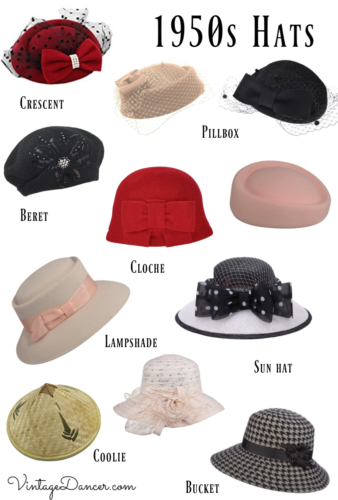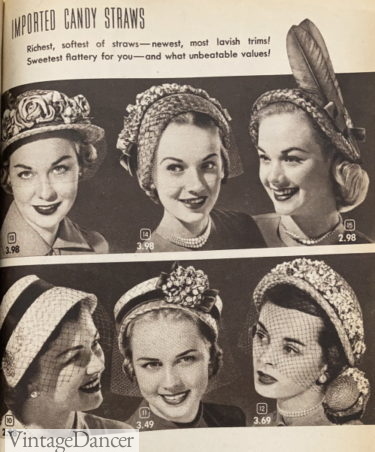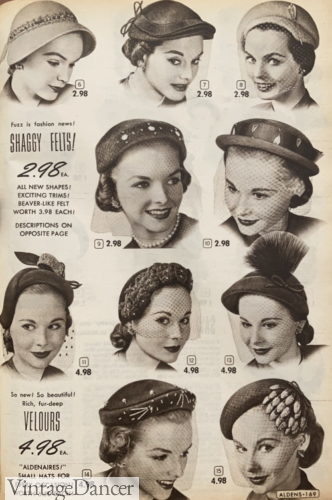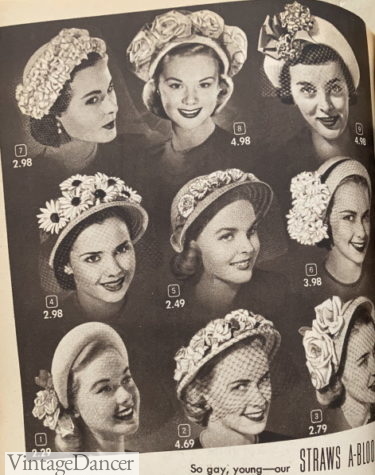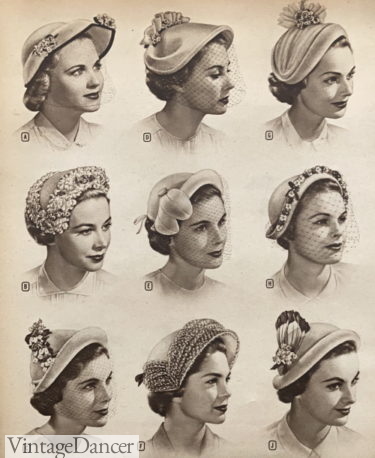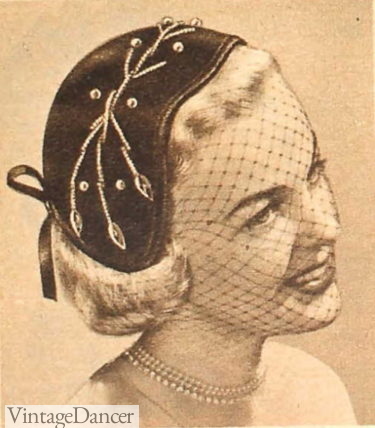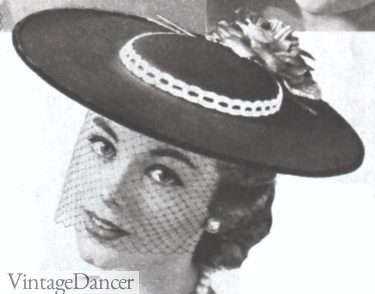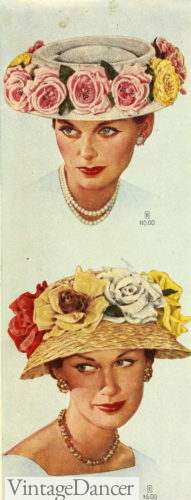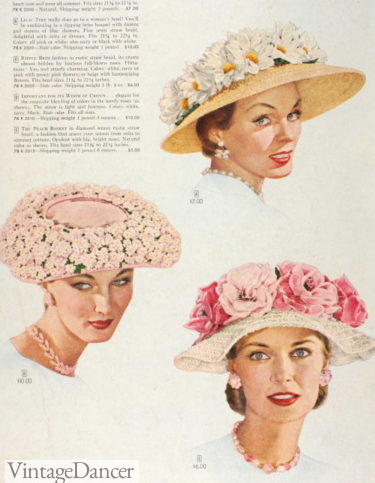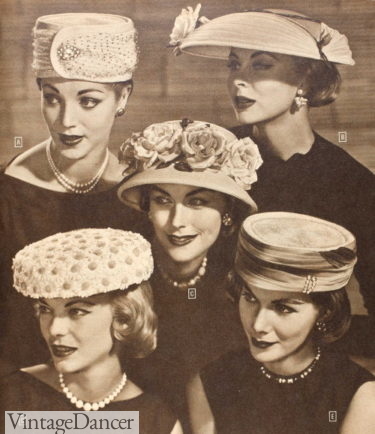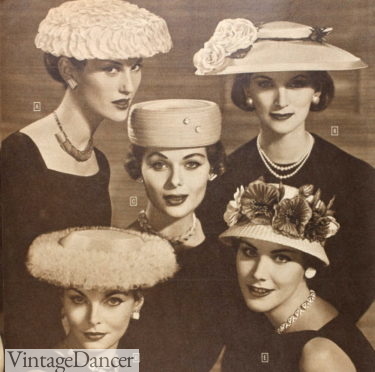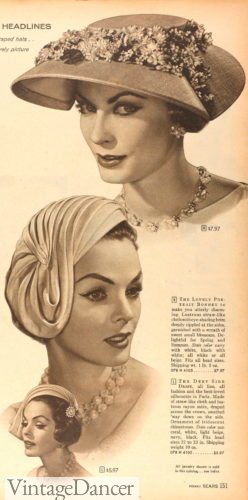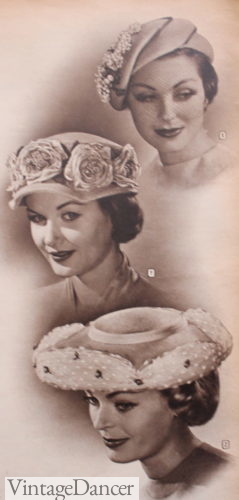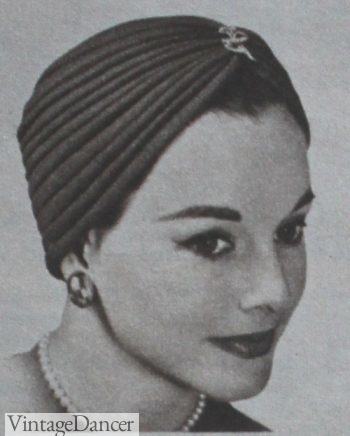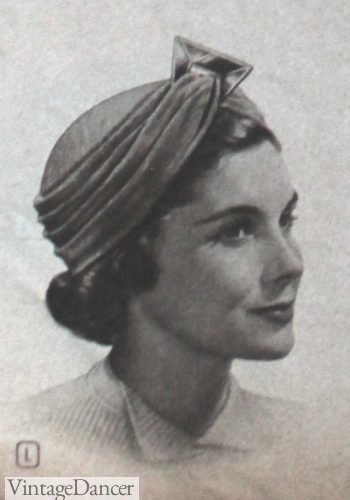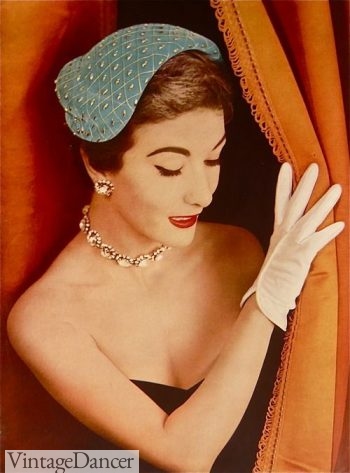
1950s Velvet Crescent Hat with Pearls
1950s hats were still worn daily by most women, however the trend to go hatless was on the rise, especially among the youth who were not advised to wear hats until past the 20 year mark. 1950s hats could be small or large with a low crown, and were held onto the head using elastic linings, combs, and clips.
1950s hats were made from straw, wool felt, velvet, lace, or satin, and were often decorated with a single feather, a cluster of beads, ribbon, small flowers, and nylon netting for veils.
Women’s 1950s hats were worn in a variety of colors to match every outfit’s accessories. 1950s hairstyles supported the changing shapes of hats or, more accurately, it was the ’50s hat that adapted to hairstyle trends.
Early 1950s Hats
In the 1940s, hats were the featured accessory. Women’s hats served a purpose — to add variety to her wardrobe, to keep spirits up during the war, and to cover unwashed hair. Now, as the New Look was established in fashion as a more dressed up and lady-like aesthetic, so were the hats.
Smaller hats called attention to the face and revealed sculpted hair. All accessories, gloves, bags, shoes, and hats competed for attention, but ultimately worked together in unifying the look. Hats were small and dainty, exposing freshly styled hair and framing a face that was now heavily painted in makeup. They were made of stiff fabrics, supported by wire and starched materials to maintain the clean lines and rigid shape required of the New Look.
- 1951 Candy Straw Hats
- 1953 Shaggy Felts and Velour Hats
Shell-shaped caps were the most popular style of the early ’50s in America. They sat straight on top the head and were worn with a sleek hairstyle, such as long hair pulled back into a chignon. Common styles were the mushroom brim, round coolie brim, round cloche, and Breton or half Breton.
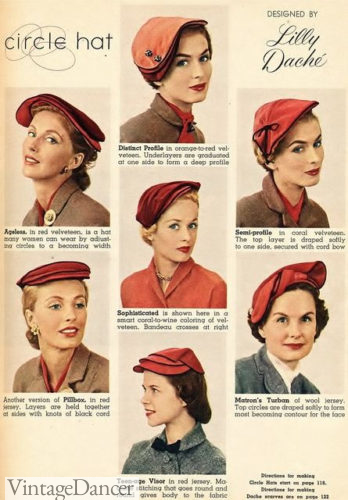
1953 Lilly Dache Circle Hats
Beaver felt began to be used in 1952, and it gave hats a brushed fur texture, sometimes called “Teddy bear cloth.” Other fuzzy, tweedy, and tightly woven straws added texture to otherwise plain, simple, and small hats. Some designers experimented with natural materials such as hats made from tree bark, wood chips, willlow, cork, and wheat strands. The rule was to wear a textured hat with a smooth dress, or a smooth hat with a textured dress.
- 1951 straw and flower trim hats
- 1954 summer straw hats
Summer straw hats were made of real straw or new synthetics like cellophane and crinoline braided into textured caps, sun hats, and bonnets. Natural straw imported from Switzerland, Italy, and the Far East leant an exotic seaside or folksy feel to summer clothing. The new synthetic straws allowed new pastel colors to coordinate with summer dresses and create even lighter small hats.
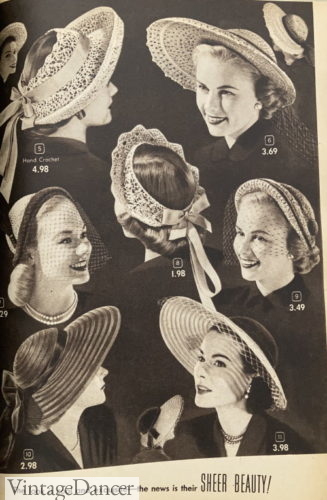
1951 Sheer Hats
Feathers were still used in hats in the early ’50s, despite the fact that Wild Bird plumage was outlawed in New York in 1950. Designers looked at other synthetic materials to trim hats: mirrors, fringe, braid, glass, jet, rhinestones, beads, and pearls. Hats often coordinated with other accessories such as a velvet turban with a velvet evening shawl or a silk hat with long silk gloves. For daywear, hats usually coordinated in color and material with shoes, handbags, gloves, belts and jewelry. At least one accessory needed to match the hat.
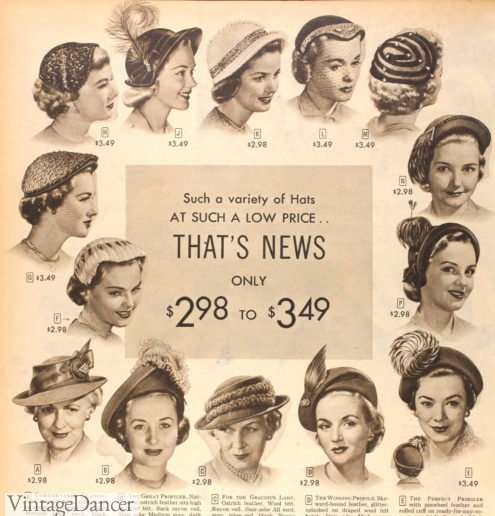
1953 Hat Styles
In 1954, Juliette caps and berets covered more of the head crown and sat slightly further back, exposing the new trend for short “Italian” hairstyles. Think Audrey Hepburn in Sabrina.
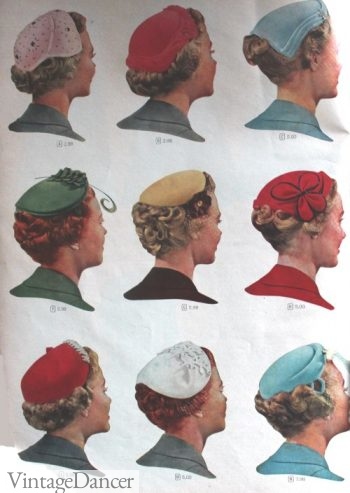
1955 Juliette Caps Framed the Crown while Leaving Short Hairstyles Exposed
Veils, in a variety of colors and metallic, hung down just a little from that crown. Besides classic black, there were orange, red, and green hats. Veils were not meant to cover the eyes but rather call attention to them.
Some Juliette hats were made entirely of veiling net. One writer encouraged women to match veils to eyeshadow.
- 1952 Velvet Hat with Face Veil
- 1957 Plate Hat with Veil Underneath
A variety of new or revived old hat shapes complemented the classic and stylish fashion of the ’50s. Hats like a bicorn-bonnet, tricorn-cloche, sailor-coolie, and helmet-toque merged two looks into one.
Even the 1920s cloche had a revival by Dior in 1953, although it hardly resembled the Art Deco era hat. The cloche crown was deeper and the overall dimension narrower so that it sat on top of the hair, adding height instead of covering hair up like a helmet.
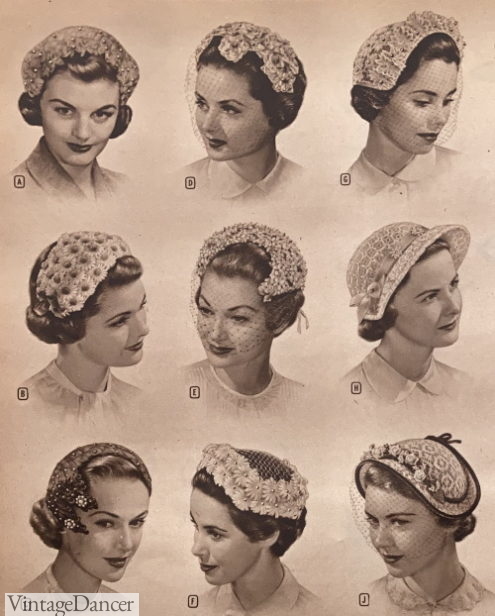
1954 Flower-Trimmed Small Hats
Hats covered with flowers, worn in winter, were a brief trend inspired by the coronation of Queen Elizabeth the 2nd in 1954. From here on out, many hats in spring and summer featured flowers, large and small.
Flower caps placed small flowers all over the hat, while garden hats placed flowers around the brim. When it came to flowers, it was an all or nothing experience. They were the focal point of the hat.
Mid to Late 50s Hats
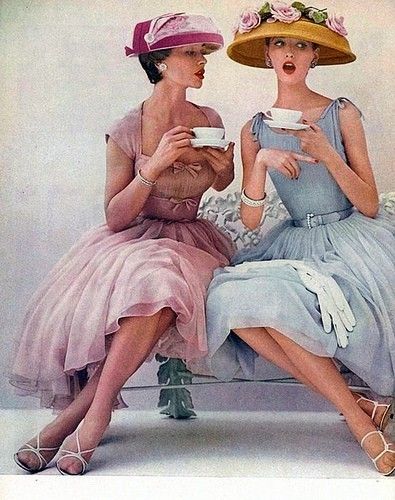
1950s Tea Hats and Dresses
In 1956, the musical My Fair Lady created a revival of Edwardian era hats (AKA Titanic era hats). Hats grew bigger and more dramatic with lots of large ribbons and flowers. Exotic silk turbans fancied up evening occasions. Wide brim sun hats with piles of flowers revived the garden party in Spring.
The milliner’s challenge was to make hats large but light so as not to compress hair. Rough straw, organdy, net, tulle, and silk were gathered, ruched, layered, and stitched to add bulk without weight.
- 1957 Garden Flower Hats
- 1957 Spring Picture Hats
Also in 1956, hats turned tropical, perhaps in anticipation of Hawaii’s statehood in 1959. Large straw sun hats or tall bucket straws matched straw beach bags and espadrille sandals.

1954 large brim straw hat with faux fruit
In winter, a large toque, fur beret, or feathered wide brim hat brought drama indoors. Bulky hats that needed support were made possible by the French Twist hairstyle. Winter hats also favored unique furs such as leopard, mink, white fox, and otter. Cheaper options were angora hair, velvet, and shaggy velour.
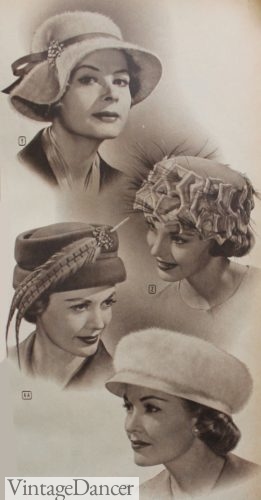
1959 Winter Cloche Hats
By 1958, the bouffant hairstyle with full bangs, rolls, and curls was in style. When hats were worn, they were small draped satin toques or feathered helmets that mimicked the bouffant hair. Hair was in, hats were out — and hat sales dropped 37% that year. Ouch.
- 1957 Dramatic Hats
- 1957 Volume Hats
That wasn’t the end of hats quite yet, however. Hats went unchanged between 1957 and 1959 with only the addition of printed material hats. Flowers were printed on felt, cotton, and even straw, adding some charm to ladies’ spring hats. The floppy brim hat extended out past the forehead, partially adding sun protection.
- 1958 Shaped Side Drooping Hat
- 1958 Flowers and Veiling Trim Hats
Many women must have had bad haircuts in the later ’50s, because milliners made close fitting skull cap hats that covered up the entire head. They were covered in feathers, fur, flowers, or manipulated fabrics. The result was “Wig-toques” — hats that looked like wigs of hair but made of unusual materials.
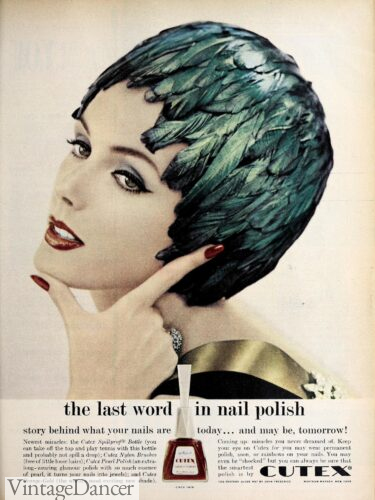
1958 feather wig toque hat
The wig shape could be full like the bouffant, or flat like a pixie cut. It was dramatic for the “in” fashion elite, but made little effect on the everyday woman. The look wasn’t terribly inventive. Similar hats were seen around 1952 but never took off.
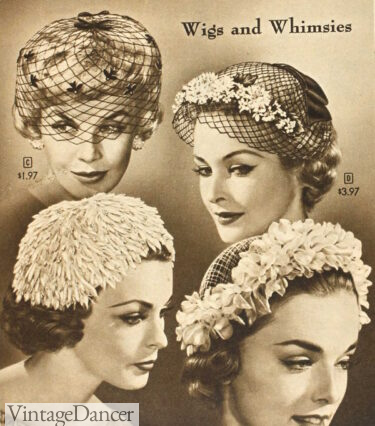
1959 whimsies and wig hats
By 1959, the bouffant hair supported tall hats such as the upside-down flower pot, lampshade, or bucket cloche. The round edge framed the hair and face but never came down over the forehead like 20s cloches did. They came in a rainbow of ice cream colors and fuzzy winter textures, adding new life to the fading fashion accessory.
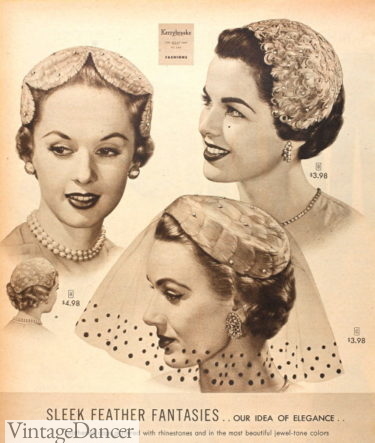
1954 Feather Covered Hats
Hat Pieces
The last millenary invention of the 50s and the only style that did not crush the bouffant were beaucoiffs or whimsies. It was a simple headband with an attached small veil, cluster of flowers, ribbon bow, or feather band.
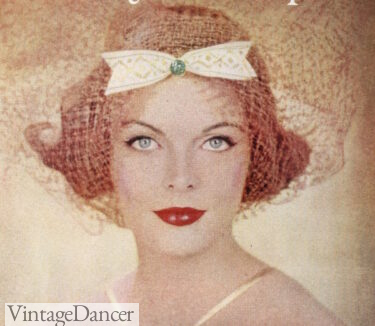
1956 bow and veil whimsie hat (or not a hat)
It generally slipped on the head and added a little decoration without the fullness and stigma of an old ladies’ hat. They made up of 25% of all hat sales in the last two years.

1957 Whimsies
The other non-hat hat was the chignon cap that covered the bun of women’s long hair around 1957. A pillbox shaped scarf, a flower-covered bob, and faux braided hair were just a few of these creative styles. It was a fad and it didn’t last too long, but I think that they are classy!
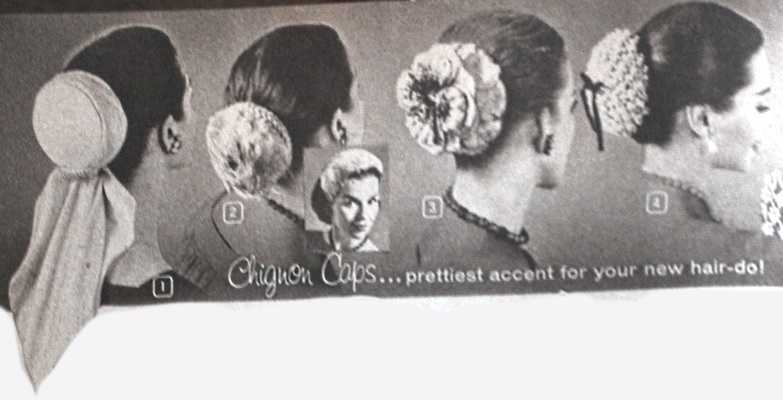
1957 Chignon Caps
Young women, lower “working” classes, and fashion forward dressers avoided wearing hats except to church or perhaps out shopping, where they may have received better service. A woman who wore hats was thought to be of mature years, had wealth, lived in the city, or was in an executive business position.
Hatted women were treated better than casual hatless girls. The youth didn’t wear hats and casual middle-class women followed the trend.
It would be only a few more years before hats disappeared from women’s heads entirely, and a few more after that until they returned as a fashionable accessory for the youth driven generation of the 60s.
1950s Hat Styles
Here is a brief overview of common 1950s hat styles. Keep in mind that each designer, retailer, region, and individual women had different names for similar hats. For example, one of my ’50s catalogs labeled a mushroom hat as a pillbox hat, which was called a bumper in another catalog. There were so many styles of hats that the names couldn’t keep it straight!
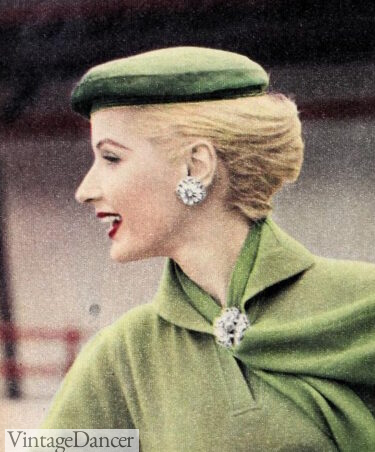
1956 – a hat with many names
One quick note on 1950s fascinator hats: the term fascinator was first used many centuries ago to describe a knit hat. It returned in the 1990s to describe small, perched, often veiled, cocktail hats. Since most hats in the 1950s were small and perched, the fascinator is a fair name.
If you wear a fascinator hat, do not not wear it an an steep angle. 1950s hats were worn straight on the head, perfectly centered. There were some slightly angled hats in the early 50s but not the hanging off the side of the head look most modern fascinators are designed for.
Plates, Platters, Saucers, Mushroom Hats
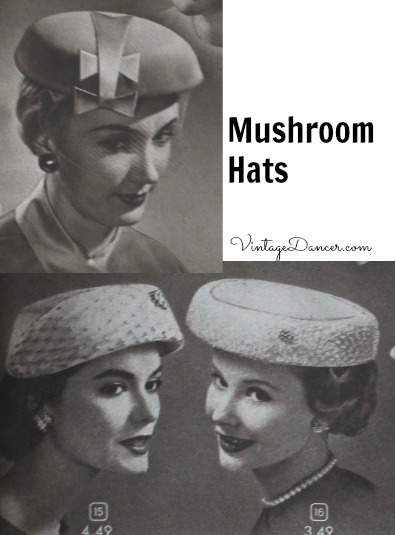
1950s Mushroom Hats, 1957
The one hat style to dominate the 1950s was the flat hat — a round, circular, thin hat that came in a variety of names from the kitchen. Plate, platter, or tambourine hats were completely flat; saucer hats had a slight downturned edge; and mushroom hats had a deep downturned brim all around.
The early years favored small plate hats that circled the head like a halo. Later years saw the hats grow wide for a bigger framing of the face. Trim could be minimal or fussy with rows of lace ruffles, pleated gathers, fuzzy fur, or layers of small feathers. If the hat was plain, a pretty brooch could be clipped to the brim of a mushroom hat.
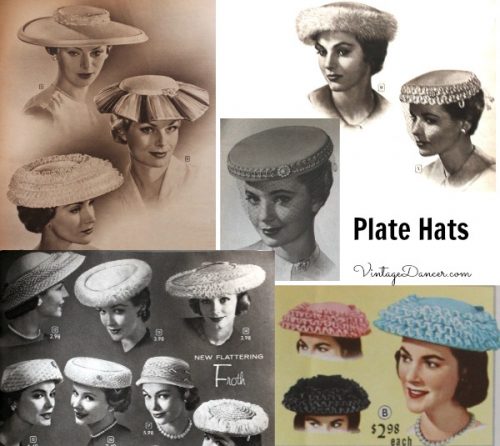
1950s Plate and Mushroom Hats
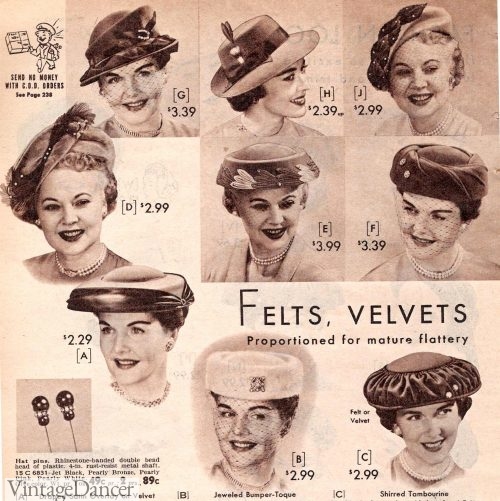
1957 Hats for Mature Women
One unique hat was the flying saucer. Flying saucer hats, also called coolie hats, were shaped like, well, flying saucers. They were wide at the bottom and came to a rounded point at the top. Many had long thin veils. They were fairly flat – the slope of the sides wasn’t steep, and the brims were wide – and could even be a foot or two in diameter, but most were small enough to create the halo effect.
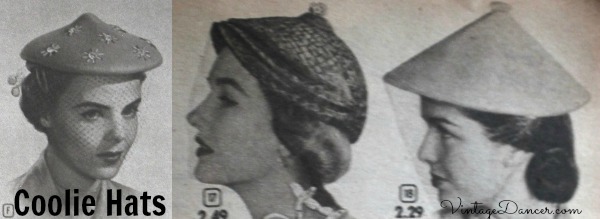
1950s Coolie Hats, Flying Saucers
1950s Cloche Hats
Audrey Hepburn looked fabulous in all hats from pillbox to sun hats, but it was her Tiffany cloche that fit her gamine look to perfection. The Tiffany cloche featured a “slightly rounded brim, which encased her face down to the eyebrows” (Century of Hats).
The 1950s cloche is more or less a bucket hat or upside down flower pot with an angled brim. Smooth felt or textured furs and velvets added dimension, while the trim was minimal. A simple narrow ribbon band with a brooch, pin, jewel, or flat bow to one side.
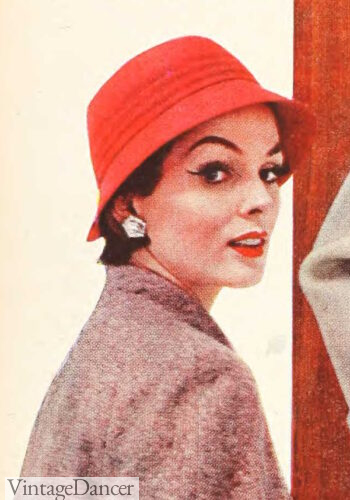
1957 red cloche hat
Some early cloches had short brims and rounded crowns, while the later styles had angular crowns and flat tops.
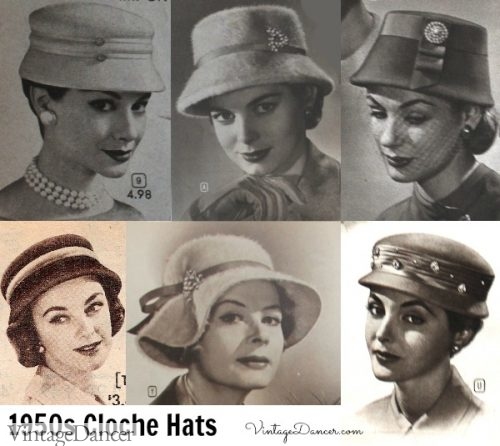
1950s Cloche Hats
One unusual cloche hat was the lampshade hat. It had corrugated sides, no brim, and an open crown. A homemade version took an old record and melted it into a bowl to create the folds. Any women who dared to wear it faced many stares and snide remarks. It was utterly ridiculous.
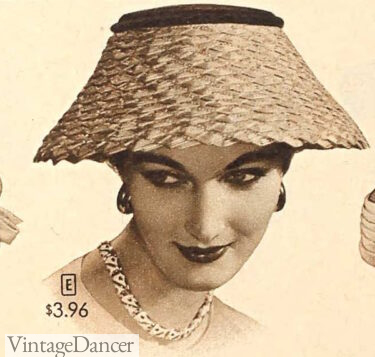
1957 lampshade hat
1950s Pillbox Hats
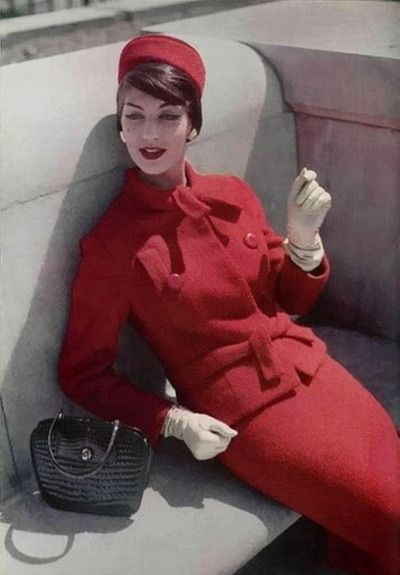
1957 Jean Patou Red Suit and a Pillbox Hat
Pillbox hats continued to be a popular small hat style from the 1940s. They were circular shaped and a few inches tall, with straight sides and a flat or slightly rounded top that covered just the peak of the crown of the head or perched flat on top.
As the decade moved on, the depth of the crown grew to 4 or 5 inches tall. The popularity of the pillbox hat also grew, becoming one of the few ’50s hats to survive into the 1960s. Jackie Kennedy was wearing a pink pillbox hat the day John F Kennedy was assassinated in 1963.
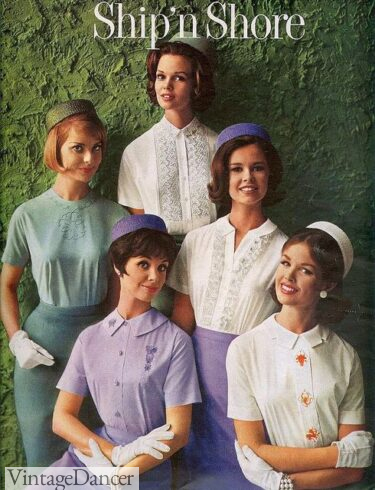
Ship N’ Shore blouse ad wearing pillbox hats
Pillbox hats looked especially polished with a tailored suit. The clean, undecorated shape mimicked that of the simple lines of the suit. Some pill box hats had attached net veils. Fancy versions had trim, beading, or fringe decorating the sides.
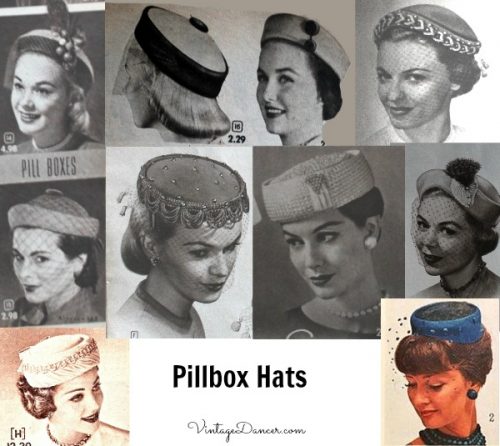
1950s Pill Box Hat (Top to Bottom Early 50s to 60s)
Caps, Crescents, Helmets, Half Hats
Most early to mid ’50s hats were small crown caps. They molded to the back of the head and part way at the top. They fit snug, like a helmet, but may have exposed the hairline, sides, and back.
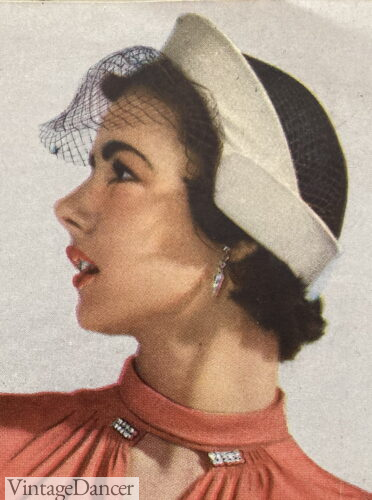
1951 helmet hat
Crescent shapes, half hats, or saddle hats only covered the top and sides of the head like an extra wide headband. These small hats were also very light. They were shaped with wire but unlined. A woman could hardly feel herself wearing one of these ultralight hats.
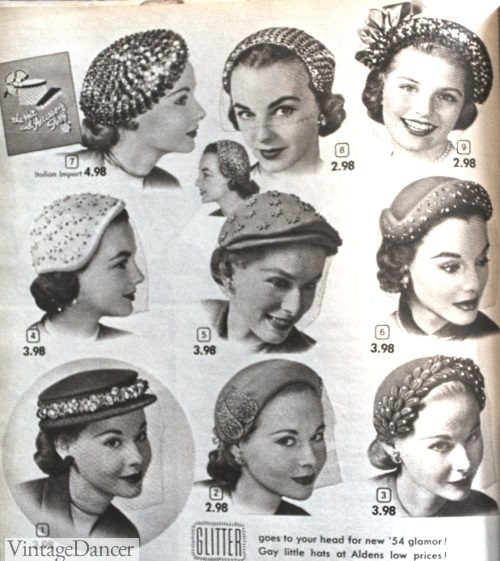
1953 Small Fancy Hats
The lightest of crescent hats were to the feather hat.
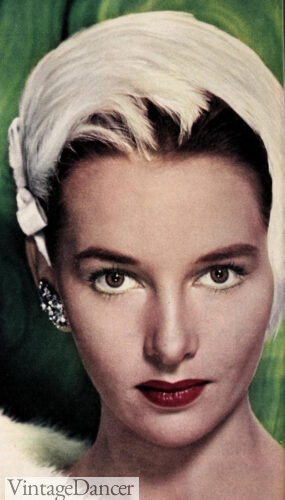
1956 feather crescent hat
French Beret Hat
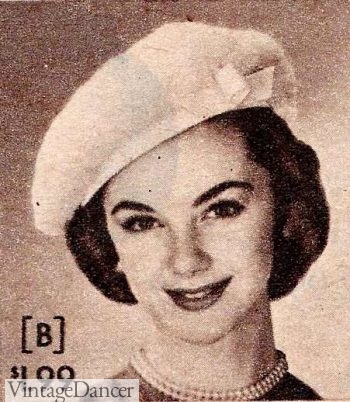
1957 Fuzzy Beret with Bow
The French beret had been in style since at least the 1920s. There was little change it its shape or size for the decades leading up to the ’50s. What was new was some additions of contrasting braid and trim such as black braid on a red beret or white cording on a green beret.
Smooth felt berets were classics, but fuzzy berets were even better. Some had beads or small pearls scattered about. Others had a charming bow on the band.
They were worn around the forehead and crown or tacked onto the top and flopped down like a tilted mushroom to frame the face. Berets were a youthful hat, gradually losing popularity by the mid-50s.
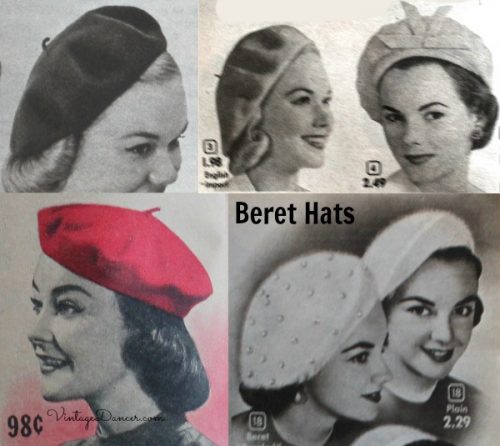
1950s Beret Hats
Turban Hat
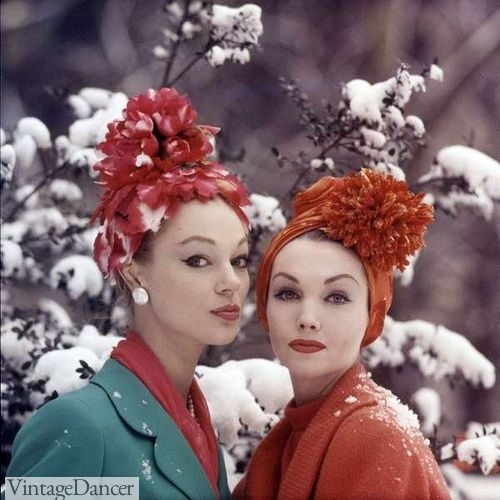
Fancy, tall, turban wraps with flowers
The turban hat was another carryover style from the 1940s. The many folds and pleats gathered up into a twist at the top created a look that was elegant and dramatic. Fit for the evenings, it was usually made of velvet or satin.
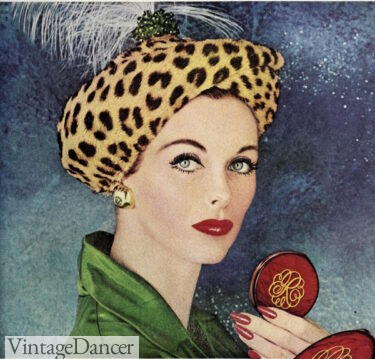
1956 leopard turban hat with plume
All the drama was a bit too much for most chic ’50s outfits, so the turban was simplified into pleats around the head like a swim cap and decorated with a single rhinestone brooch at the peak.
The turban pleating was frequently seen on hats, too. All style of hats, small and large, could have the recognizable turban folds, yet be neutral enough for daywear.
- 1953 Simple Turban Cap
- 1957 Turban Hat
Sun Hats
Sun hats were by far the widest style of hat for women in the 1950s. In the ’40s and early ’50s, they were called cartwheel hats. Made of straw or a lightweight silk, they did their job to keep the sun off the face. Pale skin was in, suntans were out.
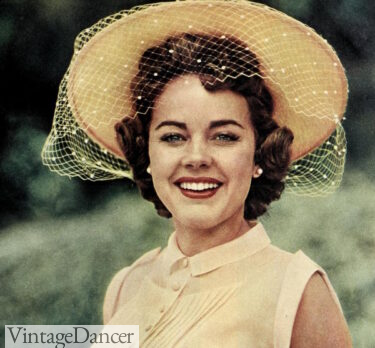
1954 Terry Moore models’ a yellow felt sunhat with veil
The ’50s sun hat slimmed down to a more manageable size for day to day wear. The crowns were very shallow and the brim angled down slightly. Large flowers and narrow ribbon were the two most common decorations. Natural straw wasn’t nearly as favored as bright colored straws such as red, yellow, blue, white, and even black. They, of course, matched a dress or playsuit.
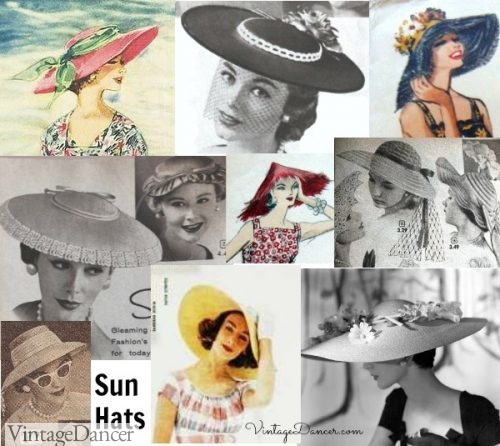
1950s Sun Hats
Read More
- 1940s Women’s Hat Styles
- 1950s Hairstyles for Women
- What Did Women Wear in the 1950s?
- 1950s Stockings History
- 1950s Handbags and Purse Styles
1950s Style Hats for Sale
Vintage 1950s hats for sale on Etsy and new vintage inspired 1950s hats sold online:
Debbie Sessions has been teaching fashion history and helping people dress for vintage themed events since 2009. She has turned a hobby into VintageDancer.com with hundreds of well researched articles and hand picked links to vintage inspired clothing online. She aims to make dressing accurately (or not) an affordable option for all. Oh, and she dances too.
